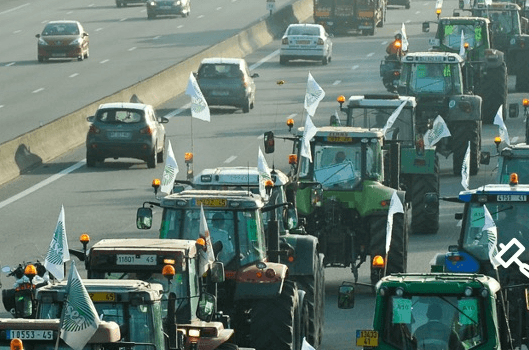Sommaire
Analysis of the farmers’ protest: data in public affairs is not a crystal ball
We've just had a major mobilisation of farmers, who expressed their frustration with a whole series of demands. Was this uprising to be expected? How was it expressed? Were the signals not heeded? I thought it would be interesting to look back at what preceded this mobilisation, using data.

Introduction
The use of data has always given rise to fantasies about prediction and the ability to forecast events. The concept of a "weak signal" is often used to describe information that we need to anticipate as to what it will become in the future. With the arrival of social networks, the Holy Grail of identifying key trends has become part of the narrative deployed by intelligence platforms.
A year of farming with the classics
In the Follaw panel, the agriculture fair generated more interactions than the farmers' mobilisation. This may seem odd, given that there were almost 3 million tweets about them, but this is a view via our panel of 17,000 people, made up of journalists, politicians, lobbies, French and European think tanks, and a few influential farmers.

In all, the most influential events of the year were :
| Salon de l'Agriculture 2023 | 9,519 Mentions | From 25 February to 5 March 2023: The Salon de l'Agriculture 2023 was the key event of the year for the agricultural sector, involving politicians, the media, associations, cooperatives and farmers. The show was also an opportunity for farmers and the general public to question the President on a wide range of issues relating to the sector as well as the environment and climate (636 mentions). |
| Mobilisation of farmers | 2,533 Mentions | The wave of mobilisation by farmers and livestock breeders, underway since the end of January and denouncing the difficulties faced by the sector, has caused a stir on social networks, but has also been used by many politicians to question European policy (particularly in relation to free trade agreements). |
| War in Ukraine | 1,333 Mentions | Relations between Ukraine and the EU, and the question of Ukraine's integration into the EU, were a key topic this year. Fears linked to Ukraine's prioritisation of French agriculture were very present. The question of the impact on the price of French food products, but also on the quality of imported products, was raised. |
| EEA study showing the link between pesticides and biodiversity loss | 1 123 Mentions | 16 May 2023 - A study by the European Environment Agency has revealed the causes of the decline in bird populations in Europe and calls for a reduction in the use of pesticides. "It points to the intensification of agriculture, with the use of pesticides and fertilisers, as the major factor, ahead of global warming".(Audrey Garric). |
| Renewal of glyphosate authorisation for 10 years by the EC | 1,010 Mentions | The authorisation of the renewal of glyphosate for 10 years at European level has raised the debate on the toxicity of the product, which has been criticised for the lack of data on its dangerousness and its impact on biodiversity. France's role in this decision has also been called into question. Ecologists, at both federal and European level, were the most active. |
| Livestock Summit | 608 Mentions | Taking place from 3 to 6 October 2023, the livestock summit has generated a great deal of media coverage. |
| European free trade agreements | 360 Mentions | Whether with New Zealand or the Mercosur countries, X has been used by many politicians to denounce the contempt and cynicism of the free trade agreements concluded by the EU. |
| Reduction in cattle numbers | 311 Mentions | The announcement of a reduction in the number of cattle in France caused a major stir, with outrage at a "desire to kill off" French agriculture in favour of imports. |
We can see, therefore, that the events/news items most discussed in connection with the mobilisation generated very few mentions of the Free Trade Agreements.
Before and after the mobilisation
If we now test the subjects and issues, and compare the period before and after the mobilisation :

We can see that before the mobilisation, pre-empted issues such as foreign competition, free trade agreements, standards and agricultural disasters are not at all well positioned and represent nothing. So it's obvious that anyone watching the data who is told to prepare a political note indicating that a mobilisation is about to take place has a huge chance of failing miserably in their preparations.
In addition to the fact that the main themes of the mobilisation were not visible, it should also be pointed out that the first call by the FNSEA and JA to return signposts from October onwards saw media coverage close to nil.
Is data a crystal ball?
As we can see, data does not allow politicians to understand that an issue is on the rise or that a protest is about to arise. This requires a very high level of responsiveness, which must be objective. Data is not and never will be predictive when it comes to social issues.
In reality, there are many selection biases. The most important is the production bias: a fairly significant bias, as it is enormous on social networks. It is estimated (Nielsen, 2011) that the ratio between those who create content and those who are completely passive is 30-70. When 70% of people are not part of the data we are observing, this is a strong bias. The other corollary of the production bias is to think that an opinion is necessarily produced. The more divisive the issues, such as the Palestinian conflict, the fewer people express their views. What's more, we don't publish our emotions or our feelings every day. Just because we're anti-meat doesn't mean we proclaim it every day either. In short, social data has to be produced in order to exist.
All this creates a form of selection bias, like the famous survivor bias whose story is often successfully propagated on LinkedIn. The statistician Wald analysed fighter planes returning from missions during the 2nd World War in order to make them stronger. To do this, he examined aircraft returning from missions and noted where they were most frequently hit in order to armour those specific parts. Wald found that the damage observed on returning aircraft did not represent the most critical points, but rather the areas where an aircraft could be hit and survive to return to base. The real 'weak points' were the areas where there was no damage on the returning aircraft, because being hit in these areas probably meant that the aircraft was lost.

This is the survivor bias that occurs when we draw conclusions based solely on information from 'survivors' or successes, without taking into account failures or absentees. With social networks, it's more or less the same thing, i.e. you have to produce in order to exist statistically.
Furthermore, our analysis is confined to network X, which is far from being the case. This network is far from representative of the French population (and our panel even less so) and has a strong tendency to structure topics of the day where everyone jumps into the breach. If you look at the volume of information on agriculture and its distribution by type of stakeholder, you can see that everyone is following the same production rate.

In short, does this mean that all the data should be discarded? No, just that its forward-looking dimension is very limited. Data are there to objectify things. They help to structure a response. You just have to be aware that while data doesn't lie, you can make it say whatever you want. Hence the need to objectify your data, to know what it's going to say... And to find that famous weak signal.



